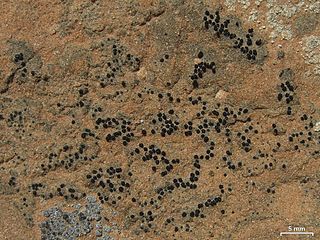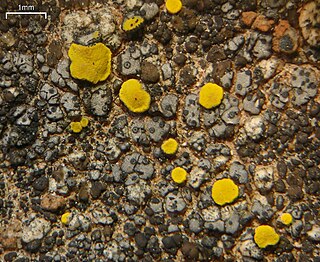
The Verrucariaceae are a family of mostly lichenised fungi in the order Verrucariales. The lichen-forming species, which comprise the vast majority of the family, have a wide variety of thallus forms, and include crustose (crust-like), foliose (bushy), and squamulose (scaly) representatives. Several characteristics of the spore-bearing structures, the ascomata, define the family, including their perithecioid form–more or less spherical or flask-shaped, with a single opening and otherwise completely enclosed by a wall. Squamulose members of the Verrucariaceae with simple ascospores, and without algae in the spore-bearing region are known as catapyrenioid lichens; there are more than 80 of these species. The family has several dozen lichenicolous (lichen-dwelling) examples, and a few genera that contain solely lichenicolous members. An unusually diverse variety of photobiont partners have been recorded, mostly green algae, but also brown algae and yellow-green algae.
Agonimia is a genus of lichen-forming fungi in the family Verrucariaceae.
Neocatapyrenium is a genus of squamulose lichens in the family Verrucariaceae. It has five species. The genus was circumscribed by Hiroshi Harada in 1993, with Neocatapyrenium cladonioideum assigned as the type species.

Verrucaria is a genus of lichenized (lichen-forming) fungi in the family Verrucariaceae.

Thelidium is a genus of lichen-forming fungi in the family Verrucariaceae. The genus was circumscribed in 1855 by Italian lichenologist Abramo Bartolommeo Massalongo, who assigned Thelidium amylaceum as the type species.

Staurothele is a genus of saxicolous (rock-dwelling), crustose lichens in the family Verrucariaceae. It has about 40 species. When the fungus is part of a lichen, the genus of lichen is commonly called rock pimples.
Scleropyrenium is a genus of squamulose (scaly) lichens in the family Verrucariaceae. It has two species. The genus was circumscribed in 1993 by Japanese lichenologist Hiroshi Harada, with S. japonicum as the type species. Characteristics of the genus include a dark brown to almost black exciple, pycnidia of the Staurothele-type, and a pachydermatous upper cortex.
Sarcopyrenia is a genus of lichenicolous (lichen-dwelling) fungi. It has 11 species. It is the only genus in Sarcopyreniaceae, a family in the order Verrucariales. Sarcopyrenia was circumscribed by Finnish lichenologist William Nylander in 1858, with Sarcopyrenia gibba assigned as the type species. Sarcopyreniaceae is one of the few families composed entirely of lichenicolous fungi.
Verrucaria rupestris is a species of lichen belonging to the family Verrucariaceae.

Verrucaria nigrescens is a widespread species of crustose lichen in the family Verrucariaceae. It was first formally described as a new species by Christiaan Hendrik Persoon in 1795. The lichen produces a very dark brown thallus that grows on rocks; the medulla is black. There are black perithecia that resemble buried dots, and which measure 0.15–0.3 mm in diameter. Ascospores measure 14–24 by 7–11 μm.
Graphium samogiticum is a little-known species of lichenicolous (lichen-eating) fungus in the family Microascaceae. It is found in Lithuania, where it parasitises two lichen species that inhabit abandoned gravel pits.

Staurothele elenkinii is a species of saxicolous (rock-dwelling) lichen in the family Verrucariaceae. It was described as new to science by Ukrainian lichenologist Alfred Oxner in 1927, from the steppes of Ukraine. In 2013 it was recorded from the northeast Caucasus, in Russia. It is also widespread on dry rocks in the North American west, ranging from the Northwest Territories south to the southwestern United States. It grows on shales, sandstones, and calcareous rocks.
Halospora is a genus of lichenicolous (lichen-dwelling) fungi in the family Verrucariaceae. Species in the genus parasitise calcicolous crustose lichens, i.e., those that prefer lime-rich substrates.
Verrucaria vitikainenii is a species of saxicolous (rock-dwelling) crustose lichen in the family Verrucariaceae. It is found in Finland, where it occurs on calcareous rock outcrops.
Verrucaria oulankaensis is a rare species of saxicolous (rock-dwelling) crustose lichen in the family Verrucariaceae. It is found in north-eastern Finland, where it occurs on calcareous rocks on river shores.
Verrucaria ahtii is a species of saxicolous (rock-dwelling) crustose lichen in the family Verrucariaceae. It is found in Finland, Lithuania, Russia, and Switzerland, where it occurs on calcareous pebbles.
Verrucaria takagoensis is a species of saxicolous (rock-dwelling), crustose lichen in the family Verrucariaceae. Found in semi-freshwater habitats in Chiba Prefecture, central Japan, it was formally described as a new species in 2001 by lichenologist Hiroshi Harada. The lichen has almost spherical, exposed black perithecia measuring 0.1–0.2 mm in diameter, with brownish-black perithecial walls, and lacking a distinct involucrellum. The periphyses are 5–10 μm long with pointed apices, while its ascospores measure 6–8 by 4–5 μm. Verrucaria takagoensis has a translucent or almost transparent (semipellucid) brownish, thin thallus.
Verrucaria madida is a species of saxicolous (rock-dwelling), aquatic, crustose lichen in the family Verrucariaceae. Found in Europe, it was formally described as a new species in 2004 by British lichenologist Alan Orange. The type specimen was collected by the author west of Murat, Cantal, France at an altitude of about 1,000 m (3,300 ft). There it was growing on shallowly submerged rocks in a lightly shaded woodland stream. The lichen has a thin, smooth, dark green to dark greenish-grey thallus with a somewhat gelatinous consistency. The asci of Verrucaria madida contain four ascospores; this is highly unusual for genus Verrucaria, which typically has eight-spored asci.

Verrucaria bernaicensis is a species of saxicolous (rock-dwelling), crustose lichen in the family Verrucariaceae. It was first formally described by Alexandre François Malbranche in 1869. It has a dull, pale grey thallus that is areolate to somewhat squamulose in form. Its perithecia are immersed in the substrata, measure 0.2–0.3 mm in diameter, and lack an involucrellum. Its ascospores are broadly ellipsoid to roughly spherical, measuring 9–11 by 7–9 μm. The lichen has been recorded from Asia, a few European countries, Russia and the Caucasus, and southwestern North America.



